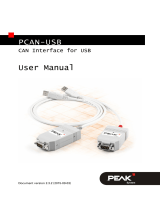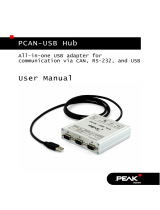
PCAN-MIO – User Manual
11
Function block Description
Identity Copies the input variable to the output variable.
Scaling Conversion of an input value, with multiplicators and
offset; the result is copied into the output variable.
Hysteresis The output is dependent on the input value set to one of
two pre-defined values.
Monoflop The output is set to one of two pre-defined values
depending on the input value for a pre-defined period.
Extended Hysteresis Depending on an input value the output is timeout
activated for a pre-defined period (set to 1). A second
input acts as an enable signal.
Switch Delay Switch-on, switch-off delay or a combination of the two.
Lowpass Realization of a lag element by a low-pass with an
adjustable time.
Characteristic Curve The input signal is converted by applying a pre-defined
characteristic curve.
Characteristic Curve
with Limit
Like the characteristic curve but in this case values
specified outside the characteristic curve are returned.
Characteristic Map The input signal is converted using a pre-defined surface
which is composed from a list of characteristic curves.
Characteristic Map
with Limit
Like the characteristic map but in this case values
specified outside the surface are returned.
Small Map The two inputs indicate a position within a grid of 12
fields. The return values of the fields are specified by the
default assignment tables.
Ramp Counter Each time a function is called the counter counts one
more step from a lower to an upper limit and then begins
again at the lower value.
Counter with Clock
and Reload Input
Counter for flanks to an input
PI Element Simple PI regulator with reference and actual value inputs
PIDT1 Element PIDT1 regulator
Difference Help function block for the PIDT1 regulator
Math Function Collection of various mathematical and logical functions
Binary Field Compiles a sequence of digital data into a binary value.

























